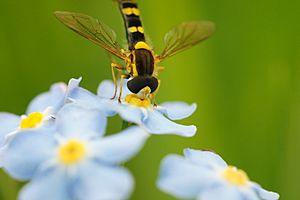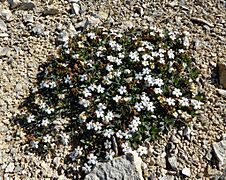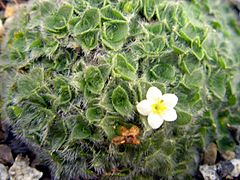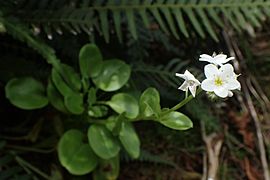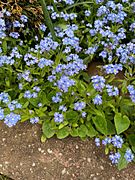Myosotis facts for kids
Quick facts for kids Myosotis |
|
|---|---|
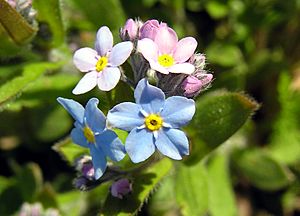 |
|
| Myosotis arvensis | |
| Scientific classification |
|
| Kingdom: | Plantae |
| Clade: | Tracheophytes |
| Clade: | Angiosperms |
| Clade: | Eudicots |
| Clade: | Asterids |
| Order: | Boraginales |
| Family: | Boraginaceae |
| Subfamily: | Boraginoideae |
| Genus: | Myosotis L. |
| Type species | |
| Myosotis scorpioides L.
|
|
Myosotis is a group of flowering plants. They belong to the plant family called Boraginaceae. The name Myosotis comes from an Ancient Greek word meaning "mouse's ear." This is because the plant's leaves look a bit like a mouse's ear!
In many parts of the world, especially in the Northern Hemisphere, these plants are known as forget-me-nots. Another common name is scorpion grasses. The Myosotis alpestris flower is special because it's the official flower of Alaska in the USA and Dalsland in Sweden. Sometimes, people confuse these plants with "Chatham Islands' forget-me-nots," but those are from a different, though related, plant group called Myosotidium.
Contents
What Forget-Me-Nots Look Like
Forget-me-nots are plants that can live for just one year (annual) or for many years (perennial). They are not woody like trees, but have soft stems. Their flowers are usually small, about 1 centimeter (less than half an inch) across. Each flower has five petals and five sepals (the leaf-like parts that protect the bud).
The flowers can be blue, pink, white, or yellow, and they often have a yellow center. They grow in a special spiral shape called a "scorpioid cyme," which looks a bit like a scorpion's tail. This is why some are called "scorpion grasses." The leaves grow one after another along the stem.
Forget-me-nots usually bloom in the spring. In cold, mountainous areas, they flower soon after the snow melts.
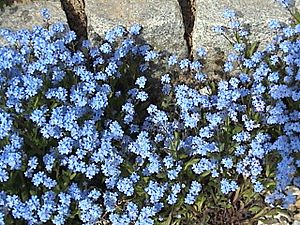
The seeds of forget-me-nots are found in tiny, tulip-shaped pods along the stem. These pods can easily stick to clothes or animal fur. When they fall off, the small seeds inside can then grow in a new place. You can collect the seeds by shaking the stems over a piece of paper.
Where Forget-Me-Nots Grow
Most Myosotis species are found in western Europe and Asia. There are about 60 different types there. New Zealand is also home to many unique kinds, with about 40 species found only there. A few types grow in other places like North America, South America, and Papua New Guinea.
Today, you can find forget-me-nots in many places around the world that have a mild climate. This is because people have planted them in gardens, and some have escaped into the wild. They like places that are moist, like wetlands and riverbanks.
One or two types from Europe, especially the "woodland" forget-me-not (Myosotis sylvatica), have spread to most mild regions in Europe, Asia, and the Americas. Scientists believe that the Myosotis group first appeared in the Northern Hemisphere. The species found in New Zealand, Australia, New Guinea, and South America likely came from one plant that traveled from the Northern Hemisphere a long time ago.
Ecology and Life Cycle
Forget-me-not plants are a food source for the young forms (larvae) of some butterfly and moth species. For example, the larvae of the setaceous Hebrew character moth eat them. Sadly, many of the Myosotis species in New Zealand are currently in danger of disappearing.
Gallery
Symbolism of Forget-Me-Nots
The small, blue forget-me-not flower has a lot of special meanings.
Masonic Symbol
In 1926, a group called the Grand Lodge Zur Sonne in Germany first used the forget-me-not as a symbol for Freemasonry. Later, during World War II, the Nazi Party used a similar forget-me-not badge for their charity drives. This allowed Freemasons to secretly wear the forget-me-not badge to show they were members, even though Freemasonry was banned by the Nazis.
After the war, in 1948, the forget-me-not became a Masonic symbol again. Today, Freemasons around the world wear this badge to remember all those who suffered because they were Freemasons, especially during the Nazi era.
Remembrance and Awareness
- In Newfoundland and Labrador, Canada, the flower is used to remember people from the province who died in the First World War. People wear it around July 1st.
- In Germany, it's used to remember soldiers who died in the world wars, similar to how remembrance poppies are used in the UK.
- The flower is also a symbol for the 100th anniversary of the Armenian genocide. The design has a black dot for the past suffering, light purple parts for unity, five purple petals for the future and the five continents where Armenians live, and yellow in the center for eternity.
- In Lithuania, the flower is a symbol to remember the January events of 1991, when people fought for their freedom.
- In the Netherlands and New Zealand, the forget-me-not is a symbol for foundations that help people with dementia and Alzheimer's disease.
- In art history, especially in old portraits, the forget-me-not is often used to remember loved ones who have passed away.
See also
 In Spanish: Nomeolvides (planta) para niños
In Spanish: Nomeolvides (planta) para niños


